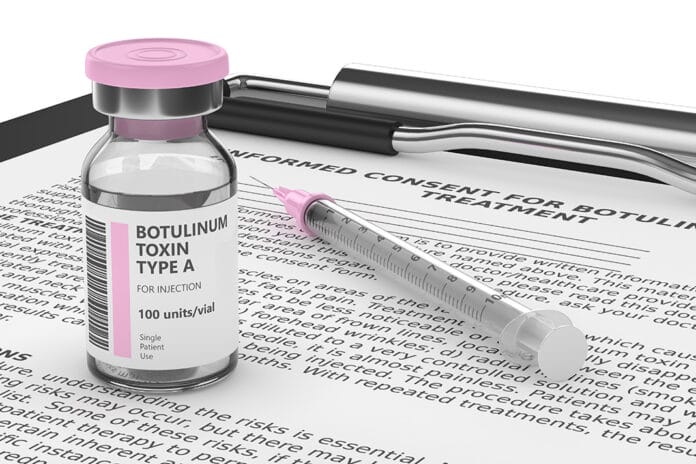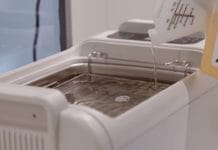Patients often tell dental professionals how much they do not care for their dental visits. For that reason, dentistry continually searches for ways to improve the patient experience with the most pain-free and minimally invasive treatment options. Botox may be commonly associated with smoothing wrinkles, but the treatments are well-positioned to become the standard of care with multiple dental procedures, including cosmetics, orthodontics, and the management of temporomandibular joint disorders.
Botulinum toxin was first discovered by Dr. Emile van Ermengem, a bacteriologist, in 1895. It is produced under anaerobic conditions by Clostridium botulinum. Botulinum toxin is one of the most lethal toxins known and was the first accepted for therapeutic uses.1,2
Botulinum toxins can be differentiated into seven types: A through G. Sommer isolated botulinum toxin-A in a purified form in the 1920s. Commercially available variants are purified exotoxin, and only types A and B are marketed, including Botox (USA), Dysport (Europe), Xeomin (Germany), Prosigne (China), and type B as Myobloc and Neurobloc.1,2
Botox Method of Action
Botox produces transient dose-dependent weakening of muscle activity. When injected into a muscle, it attaches to nerve endings of motor muscles, blocking acetylcholine release and causing muscles to relax. Once the motor nerve endings are interrupted, the muscles cannot contract.1,3
Botulinum toxin affects the nerves connected to motor neurons without affecting the nerves connected to sensory neurons, which are the receptors needed to feel pain, temperature, and touch.4 Neuromuscular transmission is re-established after three to four months as new axonal terminals form. The blockade is temporary, and botulinum toxin therapy is considered palliative, not curative.2
Botox Uses in Dentistry
Type A botulinum toxin strain was first approved by the FDA under the trade name Botox in 1989 for the treatment of strabismus, blepharospasm, and hemifacial spasms. Approval for the treatment of cervical dystonia and glabellar lines followed in 2000 and 2002, respectively. Botulinum toxin offers a new option for dental patients where conventional treatment methods like drug therapy or surgical intervention have not been successful.1,5
In North America, 20% of dentists are providing Botox as part of comprehensive dental treatment plans for excessive gingival display, orthodontic relapse due to severe muscle movement, sialorrhea, trigeminal neuralgia, hemifacial spasms (HMS), and temporomandibular joint disorders, and oromandibular pain.1,3
Temporomandibular joint disorders (TMJD) include a spectrum of disturbances associated with the functions of the masticatory system. These disorders may be myofascial (related to muscles) or arthrogenic (related to the TMJ).2
Tension-type headaches (TTH) are chronic and common in more than 15% of Americans, according to the American Dental Association. TTH is a frequent spontaneous primary headache lasting at least 30 minutes daily or occurring 15 days a month for three months. It affects the occipital and temporal regions with a bilateral constant dull ache of mild to moderate intensity without a pre-existing aura, vomiting, or nausea.6
If a patient with TTH reports a decrease in headache intensity after the management of TMJD, a correlation between the two may be confirmed. A 2016 study used intramuscular injections of Botox in the masseter muscle and found positive alterations in pain intensity and decreased number of hours and days monthly that patients were affected by TTH. Botox may be administered every 12 weeks as an alternative to daily analgesic drug therapy.6
Bruxism is defined as repetitive masticatory activity characterized by clenching or grinding the teeth or thrusting the jaw and may occur while awake or asleep. Over time, bruxism causes tooth wear, TMJD, muscular pain, joint locking, and noise. Botox reduces muscle activity and has analgesic properties helpful for associated pain.1 Botox can decrease the frequency of bruxism episodes and lower biting pressure by up to 20% to 30% in the masticatory muscle. Using Botox has provided better clinical results than occlusal splints, drugs, or cognitive-behavioral therapies.7
TMJ dislocation is an excessive forward movement of the condyle beyond the articular eminence with a complete separation of the articular surface and fixation in that position. Acute occurrences of TMJ dislocation are common and may be spontaneous, post-traumatic, or associated with psychiatric illness. Recurrent dislocation is rare.8
The first step in treatment is the manual repositioning of the condyle with a Nelaton maneuver. Botox may then be injected into two sites near the zygomatic arch and sigmoid notch. This treatment has shown effectiveness from three months up to two years in preventing the reoccurrence of dislocation.1,8
Blepharospasm and oromandibular dystonia (OMD) are focal dystonias characterized by patterned, repetitive muscle contractions. Blepharospasm most commonly includes the bilateral orbicularis oculi muscles. Oromandibular dystonia involves oropharyngeal and jaw muscles with variable presentations of the mouth, tongue, jaw, and lower facial movements.9
Oromandibular dystonia is the most commonly associated dystonia with blepharospasm. OMD is associated with TMJ pain and oral injury. Botox became the standard of care for these dystonias in 1989 and is widely accepted as first-line therapy. Although sessions are tailored for each patient, injections begin around the orbicularis oculi in four to five sites; 10U per site, not exceeding 200U total for a session, is common.9
Hemifacial spasm (HFS) is not a dystonia but a peripheral myoclonus characterized by unilateral orbicularis oculi contraction or “twitching” that can also involve lower facial muscles. Botox is injected to produce temporary paralysis of hyperfunctional or spastic muscles in affected areas.9
In a comparison study of higher initial one sessions, 30U and lower 3-5U injections over a two-week period, 3-5U injections in the affected muscles over 14 days followed by a cold compress stretched the need for subsequent injections from 3.5 months to 4.8 months. Botox is one of the most commonly used treatments for HFS due to its high efficiency (89% of patients show improvement in spasms after Botox), but the treatment is not curative.1
Sialorrhea is excessive salivary flow and a major morbidity in several neurological diseases. Drooling and excessive salivary flow cause complications such as aspiration pneumonia, oral infections, tooth decay, and peri-oral skin infections.1
Botox injections into the parotid and submandibular salivary glands have been proven effective in controlling excessive saliva production in as little as four weeks by interfering with the autonomic innervation of salivary glands and prompting a decrease in salivary flow. The effect is transient and lasts approximately three months.2,10
Trigeminal neuralgia is a unilateral neurological disorder affecting orofacial muscles, leading to acute severe pain. The trigeminal nerve carries sensation from the face to the brain. For patients who suffer from trigeminal neuralgia, the slightest stimulation to the face, such as brushing teeth, can trigger intense pain.5
Botox shows promising results for patients with drug-resistant, idiopathic trigeminal neuralgia. A Botox dose of 100U is common, but may go up to 200U, and it is injected near the zygomatic arch. Patients can expect no recovery time and relief for three to six months before the need to repeat injections.1
Excessive gingival display occurs in approximately 7% of men and 14% of women. Displaying more than 3 mm of gingiva while smiling is considered a “gummy smile” and an aesthetic disorder. Etiology may include excessive muscle contraction, lip length, clinical crown length, alveolar extrusion, dentoalveolar extrusion, and vertical maxillary excess. Corrective procedures include gingivoplasty, orthodontic teeth intrusion, orthognathic surgery, and bone resection. These procedures can be complex and costly.11,12
Botox has proven effective in reducing excessive gingival display caused by hyperfunctional upper lip elevator muscles. However, the effect is transient.
Injections at three sites bilaterally into the levator labii superioris and levator labii superioris alaeque nasi muscles of four to six units on each side were shown to reduce gingival display by 3.51 mm to 4.14 mm at a two-week follow-up with effects lasting more than three months.11,12 Botox has the benefits of immediate results without the removal of tooth structure. The disadvantages are cost and the need to repeat treatment two to three times a year.3
Orthodontic relapse can occur from strong to severe muscle movement, especially a strong mentalis muscle. Botox may be used to reduce the intensity of muscle contractions post-treatment and assist in retraining muscles to a more physiological movement. As an off-label use for Botox, there is currently no standard for this treatment.3
Dentures can be difficult for patients who have been edentulous for a long period and have become over-closed. The strong, irregular muscle contractions may cause patients to have a hard time wearing a new set of dentures. Botox injected bilaterally into the depressor anguli helps to relax the irregular muscle contractions and allows patients to adjust to new dentures.2,3
Implants may fail from stress due to any excessive functional force or parafunctional habit. Botox has been postulated to be therapeutically beneficial by allowing unimpeded osseointegration of implants. However, more extensive research is needed to assess how much Botox may improve the chances of osseointegration of implants in patients with a history of severe clenching or bruxism.2
Botox Preparation
Botox is prepared by lab fermentation of C. botulinum, which lyses and excretes the toxin into a culture. The toxin is harvested, purified, crystallized with ammonium sulfate, diluted with human serum albumin, lyophilized, bottled in quantities of 100U, and sealed.5
The estimated human lethal dose of Botox is 3000U.5 The maximum recommended dose for dental applications at one session is 80U to 100U.2
The preparation must be used within four hours, and topical or ice may be used to anesthetize the injection area. Males may require more due to muscle mass. However, the clinician should always start with the lowest dose, and muscles should never be fully paralyzed. Injections more often than once every 12 weeks should be avoided due to the possibility of antibody formation, causing treatment to be less effective over time.2
Botox Contraindications
Adverse reactions to Botox are localized and uncommon. Side effects may include a temporary change in facial expression, allergic reactions, rash, itching, headache, neck or back pain, muscle stiffness, difficulty swallowing, or shortness of breath.2
Contraindications to use include any known hypersensitivity to botulinum preparations, infection at the injection site, and psychologically unstable patients.5 Botox is a category C drug for pregnancy and should only be used if the potential benefit outweighs the potential risk to the fetus.2
Patients receiving treatment with aminoglycosides, anticholinergic drugs, or other agents interfering with the neuromuscular transmission or muscle relaxants should be closely observed because the effect of Botox may be potentiated. Patients suffering from peripheral motor neuropathic diseases, sclerosis, or any neuromuscular junction disorders such as myasthenia gravis are at risk for clinically significant adverse reactions and should be closely monitored.2,5
Dental Regulations and Training for Botox
Almost half of the states and some Canadian provinces allow dentists to perform Botox procedures in all oral and maxillofacial areas. Certification of at least 16 hours of live hands-on training is required.3 Botox can be used in a dental office as part of a comprehensive treatment plan within the scope of a dental practice and not as a stand-alone procedure.
Regulations vary from state to state, and it is recommended that dentists and dental hygienists check their state licensing board to determine the allowable uses of Botox in-office.4
In Conclusion
Botox provides immediate results, no recovery time, and minimal risk of complications, making it a promising alternative to more invasive surgical therapies or cases not responsive to traditional therapy options. Dental professionals should discuss the possibility of drug resistance over time, risks, benefits, cost, number of appointments, and a need for maintenance visits associated with Botox administration.4
Before you leave, check out the Today’s RDH self-study CE courses. All courses are peer-reviewed and non-sponsored to focus solely on high-quality education. Click here now.
Listen to the Today’s RDH Dental Hygiene Podcast Below:
References
- Serrera-Figallo, M.A., Ruiz-de-León-Hernández, G., Torres-Lagares, D., et al. Use of Botulinum Toxin in Orofacial Clinical Practice. Toxins. 2020; 12(2): 112. https://doi.org/10.3390/toxins12020112
- Srivastava, S., Kharbanda, S., Pal, U.S., Shah, V. Applications of Botulinum Toxin in Dentistry: A Comprehensive Review. National Journal of Maxillofacial Surgery. 2015; 6(2): 152-159. https://doi.org/10.4103/0975-5950.183860
- Botox – Wrinkle Treatment. (n.d.). American Academy of Facial Esthetics. https://www.facialesthetics.org/patient-info/facial-esthetics/wrinkle-treatment/botox/
- Raymond-Allbritten, J. (2018). Botox in Dentistry: This Treatment Isn’t Just for Cosmetics Anymore. Colgate Professional. https://www.colgateprofessional.com/hygienist-resources/tools-resources/botox-in-dentistry
- Azam, A., Manchanda, S., Thotapalli, S., Kotha, S.B. Botox Therapy in Dentistry: A Review. Journal of International Oral Health. 2015; 7(Suppl 2): 103-105. https://www.ncbi.nlm.nih.gov/pmc/articles/PMC4672850/
- Pihut, M., Ferendiuk, E., Szewczyk, M., et al. The Efficiency of Botulinum Toxin Type A for the Treatment of Masseter Muscle Pain in Patients With Temporomandibular Joint Dysfunction and Tension-type Headache. The Journal of Headache and Pain. 2016; 17: 29. https://doi.org/10.1186/s10194-016-0621-1
- Fernández-Núñez, T., Amghar-Maach, S., Gay-Escoda, C. Efficacy of Botulinum Toxin in the Treatment of Bruxism: Systematic Review. Med Oral Patol Oral Cir Buccal. 2019; 24(4): e416-e424. https://doi.org/10.4317/medoral.22923
- Fu, K.Y., Chen, H.M., Sun, Z.P., et al. Long-Term Efficacy of Botulinum Toxin Type A for the Treatment of Habitual Dislocation of the Temporomandibular Joint. British Journal of Oral and Maxillofacial Surgery. 2010; 48(4): 281-284. https://doi.org/10.1016/j.bjoms.2009.07.014
- Hassell, T., Charles, D. Treatment of Blepharospasm and Oromandibular Dystonia With Botulinum Toxins. Toxins. 2020; 12(4): 269. https://doi.org/10.3390/toxins12040269
- Corrêa, L.B., Basso, M.B., Sousa-Pinto, B., Coelho Leal, S. Oral Health Effects of Botulinum Toxin Treatment for Drooling: A Systematic Review. Med Oral Patol Oral Cir Buccal. 2021; 26(2): e172-e180. https://doi.org/10.4317/medoral.24101
- Chagas, T.F., Almeida, N.V., Lisboa, C.O., et al. Duration of Effectiveness of Botulinum Toxin Type A in Excessive Gingival Display: A Systematic Review and Meta-analysis. Brazilian Oral Research. 2018; 32: e30. https://doi.org/10.1590/1807-3107bor-2018.vol32.0030
- Suber, J.S., Dinh, T.P., Prince, M.D., Smith, P.D. OnabotulinumtoxinA for the Treatment of a “Gummy Smile.” Aesthetic Surgery Journal. 2014; 34(3): 432-437. https://doi.org/10.1177/1090820X14527603












